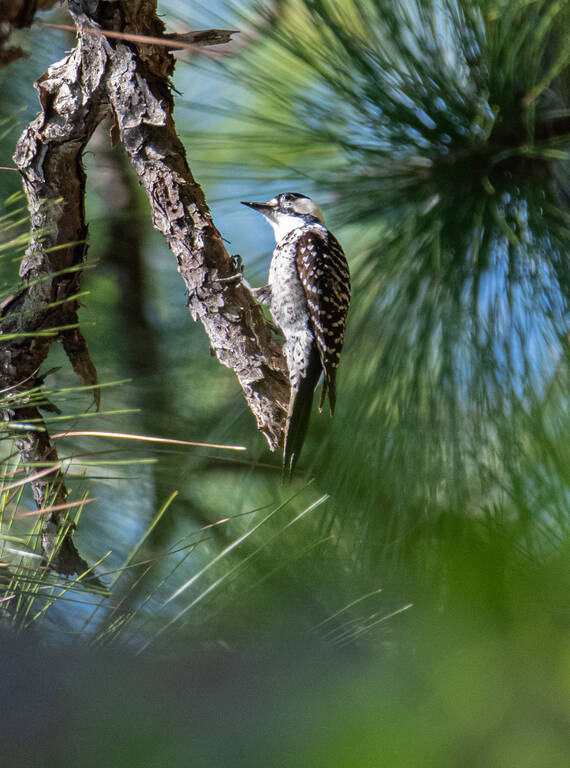In Big Thicket National Preserve’s converging ecosystems, NPCA is helping to restore the red-cockaded woodpecker and the longleaf pine forests they call home.
Big Thicket National Preserve in southeast Texas is renowned as the “Biological Crossroads of America,” where nine habitats meet to protect rich biodiversity. However, one iconic resident has been missing for decades. Once common among the longleaf pines of Big Thicket, endangered red-cockaded woodpeckers have not been seen in the preserve since the early 1990s.
NPCA’s Texas Regional Office has been advocating for the reintroduction of the red-cockaded woodpecker to the preserve, highlighting the ecological, economic and community benefits they would bring to local communities. For the past 14 years, NPCA staff and volunteers have also supported replanting of the longleaf pine forest to help make the likely reintroduction of this species possible.

A red-cockaded woodpecker.
iStock/Michael WarrenIn the early 1900s, this regal bird was abundant across the vast native longleaf pine forests that blanketed the southeastern United States. Historically, the woodpecker’s range once extended from New Jersey to Florida and as far west as Texas. Listed as federally endangered in 1970, the woodpecker now occupies just 1% of its original range. Habitat destruction and suppression of fire that enhances the growth of the longleaf pine forests they depend upon led to the woodpecker’s patchy distribution.
This woodpecker, named for the small, rarely visible red patch on the male’s head, chooses to nest exclusively in living pines. It prefers large, mature longleaf pines over 80 years old for making its home because the older trees’ wood is softer.
A cluster of mature trees is required to provide enough space to support a family group of two to eight birds. The red-cockaded woodpecker lives in cavities it hollows out in the trees — an excavation process that can take one to several years, which makes the bird highly vulnerable to habitat changes. The woodpecker also uses a rare cooperative breeding system, in which the entire family assists in creating these cavities, defending territories and raising chicks. The woodpeckers’ cavities also have been used as shelter for 27 other species — including frogs, squirrels, snakes and other birds — which makes red-cockaded woodpeckers a “keystone species” that other wildlife depend upon in the longleaf ecosystem.
Longleaf pine forests are North American treasures
These precious forests play a significant role in the Southeast’s economic and cultural development. Longleaf pine forests are home to over 1,200 species of plants and animals. Their deep root systems improve water quality for millions of Americans. A cultural symbol of the Southeast, they are the official state tree of Alabama. North Carolina’s nickname as the “Tarheel State” originated from the tree’s historical role in supplying tar, pitch and turpentine for shipbuilding.
Longleaf pine forests have shaped iconic heritage landscapes like Texas’ Big Thicket, North Carolina’s Cape Fear Arch region and the Okefenokee Swamp, which straddles Georgia and Florida.
The Southeast’s longleaf pines once rolled across 92 million acres, yet today cover less than 3% of their original range due to logging, development, extreme weather and fire suppression. The extensive decline of longleaf pine forests has caused noticeable changes in the Southeast — more than 30 species associated with longleaf pine ecosystems are now listed as federally threatened or endangered by the U.S. Fish and Wildlife Service.
Longleaf pines and the wildlife dependent on them thrive when lightning-induced, frequent, low-intensity fire stimulates the trees’ growth and reduces competing vegetation. For thousands of years, Native Americans across the Southeast long understood the important relationship between people, fire and healthy longleaf pine forests. They actively stewarded forests using controlled burns until the 1800s, when Tribes were forcibly removed from the land and fire suppression became a common forest management method among early settlers. During the last century, modern fire suppression began as forest fires were discouraged, which accelerated the decline of longleaf forests.
With support from the National Park Service and other partners, NPCA’s restoration initiative has covered 715 acres so far.
Recent conservation and management efforts across the Southeast indicate recovery of longleaf pine forests is possible. Their acreage has increased from a low of 3.4 million acres in 2010 to 5.2 million today, according to the U.S. Department of Agriculture. Subsequently, the USDA estimates the red-cockaded woodpecker population has increased from a low of fewer than 10,000 in 1990 to about 14,000 to 15,000 nationwide in recent years. Wildlife biologists and land managers attribute recent gains to the management of nesting and foraging habitat as well as prescribed fire.
However, the forests of Big Thicket have remained eerily quiet without the red-cockaded woodpecker. People would need to reintroduce them to this protected landscape.
What NPCA is doing
In Big Thicket National Preserve, NPCA’s Texas Regional Office has worked alongside the National Park Service and other partners to restore native longleaf pine ecosystems so the red-cockaded woodpeckers can possibly thrive here again.
Beginning in 2009, NPCA purchased seedlings and organized volunteers to plant 3,000 longleaf pines within the preserve as part of habitat restoration. With support from the Park Service and other partners, the initiative has grown significantly since then with trees, grasses and wildflowers planted on 715 acres so far where trees had been lost.
Along with the plantings, the Park Service has worked to remove invasive species and conduct prescribed burns.
“They take care of all the on-the-ground work to make sure these areas we’re working in are prepared for success,” said Erika Pelletier, NPCA’s associate director of the Texas and Oklahoma region.
After NPCA commissioned a survey in 2023 of the ecosystem’s health, 10 areas were identified for possible re-introduction of the red-cockaded woodpecker using artificial nesting cavities inserted into the trees for birds that would be brought in from nearby public lands. NPCA has been working with the Park Service and other partners to conduct assessments and take other steps to create a management plan for this possible re-introduction.
Reintroduction efforts are being guided by cutting-edge scientific data. NPCA’s Conservation Science team has partnered with NatureServe to produce data that shows the most suitable habitat in and around Big Thicket for woodpecker and pine restoration. Equipped with this data, Pelletier and others on NPCA’s Texas team can make strategic, evidence-driven decisions about where the woodpeckers could be introduced.
“This work could become a shining example of how you can bring an endangered species back into a park,” Pelletier said. “Our hope is that this plan is a stepping-off point. If reintroduction of the red-cocked woodpecker goes well, there are other species that haven’t been seen in the preserve that the Park Service could work to possibly bring back, such as turkey or bobwhite quail.”
Pelletier has participated in monitoring projects of red-cockaded woodpecker populations at Sam Houston National Forest and other public lands that could assist in the translocation of birds to Big Thicket. She said she’s pleased how much the Park Service and volunteers have embraced the habitat restoration idea to support the return of these woodpeckers, with tree plantings now organized three times a year — a Saturday in December and over the Martin Luther King Jr. Day and President’s Day weekends. Nearly 100 volunteers show up each time.
The plantings are also inspiring young conservationists. Sarah Bass, an environmental science major at Texas Tech University, wrote after an immersive experience with NPCA that spending time in Big Thicket learning about its diverse and fragile ecosystem “affirmed my choice of degree and direction of my career.” Observing how individuals and groups work together on small projects, like the woodpeckers, showed her what is possible. “Perhaps with time, our impact will be more than massive,” she wrote.
Why restoration matters in Big Thicket
Through these endeavors, NPCA and the Park Service are not only investing in the health of iconic longleaf forests but also the wealth of local communities. The regeneration of a vibrant longleaf pine ecosystem is expected to bring new economic opportunities through tourism and outdoor recreation, as well as cleaner drinking water and better protection from severe weather from storms, flooding and erosion.
Longleaf pine and red-cockaded woodpeckers are charismatic mascots that represent the vibrant ecology of Big Thicket, enhancing Texas’ reputation as a birdwatching haven. According to the Texas Alliance for America’s Fish and Wildlife, 4.4 million wildlife watchers annually bring in $1.82 billion in retail sales and support 146,000 jobs.
Big Thicket National Preserve stands as a prime sanctuary to bring back the red-cockaded woodpecker and restore a more complete, flourishing longleaf pine ecosystem to the region.
Want to visit?
Big Thicket joined the National Park Service as the first national preserve. It celebrates its 50th anniversary this year, with series of special events planned. The preserve is located about 90 miles from both Houston, Texas, and Lake Charles, Louisiana. Big Thicket preserves more than 113,000 acres in separate pieces of parkland. Start your visit at its centrally located visitor center.
This story originally appeared in the 2023 issue of Science News, a publication of NPCA Conservation Programs. Linda Coutant contributed to this updated version.
Stay On Top of News
Our email newsletter shares the latest on parks.
About the author
-
 Amy Tian Geospatial Science Fellow, Conservation Programs
Amy Tian Geospatial Science Fellow, Conservation ProgramsAmy is a cartographer and science communications specialist who transforms data into engaging environmental stories. As NPCA's Geospatial Science Fellow, she uses cartography, scientific illustrations, data visualization, and infographics to communicate conservation science that empowers national parks advocacy.